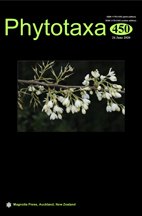Abstract
Allium schisticola is described from West Azarbaijan (Iran) as a new species. It is closely related to A. sabalense and A. sahandicum in having a similar flower color but differs by leaf, filament, and tepal characters. We investigated the phylogenetic relationship of the new species based on sequences of the chloroplast trnL-trnF and nuclear ribosomal DNA internal transcribed spacer (ITS) regions in A. subg. Melanocrommyum compared with 109 accessions of this subgenus. Our results confirm its placement in A. subg. Melanocrommyum. However, the ITS tree showed that the new species should belong to A. sect. Melanocrommyum despite the fact that it represents many morphological characters of A. sect. Acanthoprason. Most peculiar for the new species are obtuse tepals broadest near the tip (vs. very narrowly lanceolate up to triangular tepals in A. sect. Acanthoprason), with adaxially inconspicuous median vein (vs. conspicuous median vein in sect. Acanthoprason). The new species is diploid with a chromosome number of 2n = 2x = 16. Karyotype features and meiotic chromosomes behavior are presented for the new taxon. A detailed morphological description, illustrations, and a distribution map of the new species are given.

